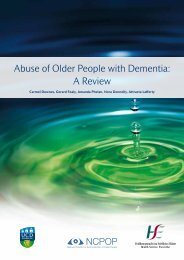Public Perceptions of Older People A literature review
Review 1 PP OP.pdf - National Centre for the Protection of Older ...
Review 1 PP OP.pdf - National Centre for the Protection of Older ...
You also want an ePaper? Increase the reach of your titles
YUMPU automatically turns print PDFs into web optimized ePapers that Google loves.
Cathalifaud and colleagues (2008) examined perceptions <strong>of</strong> a sample <strong>of</strong> nearly<br />
700 young people using a semantic differential measure and found that 68%<br />
<strong>of</strong> participants associated older people with conservatism (77% in the case <strong>of</strong><br />
elderly men and 68% in the case <strong>of</strong> elderly women). Similar findings have<br />
been observed in an Irish context. For example, the ARK Survey on attitudes<br />
to older people reported that over half <strong>of</strong> the general public believed that<br />
“older people are “too set in their ways and ideas” and 42% felt that older<br />
adults are “not willing to listen to young people’s views” (O’Connor & Dowds<br />
2005, p. 28).<br />
<strong>Older</strong> people are <strong>of</strong>ten characterised as having negative personality traits,<br />
particularly associated with elderly men. On the other hand, some traits<br />
associated with warmth, i.e. outgoing, dependability, have been used to<br />
describe older people, particularly older women. Conservatism has also been<br />
associated with older people, i.e., being perceived as having fixed ideas and<br />
not willing to listen to young people.<br />
7.5.1.6 Lonely and isolated<br />
Several studies have indicated that older people are viewed as both sad and<br />
lonely (Tan et al. 2004; Sauer 2006). Researchers have used depictions <strong>of</strong><br />
facial expressions or emotions in student drawings to ascertain their images <strong>of</strong><br />
later life. Findings indicated ambiguity in students’ perceptions <strong>of</strong> the<br />
emotional quality <strong>of</strong> later life (Barrett & Cantwell 2007; Barrett & Pai 2008).<br />
Approximately 50%-62% <strong>of</strong> drawings <strong>of</strong> older people incorporated smiles<br />
(Weber et al. 1996; Lichtenstein et al. 2005; Barrett & Pai 2008). This<br />
supports Palmore’s (1999) contention that old age can be recognised as a<br />
time <strong>of</strong> happiness, serenity and freedom from responsibilities such as work<br />
and child rearing. However, Lichtenstein et al. (2005) found that, although<br />
nearly half <strong>of</strong> the older people were drawn with smiles, follow-up questioning<br />
revealed that only about a quarter <strong>of</strong> the figures were viewed by their artists<br />
as happy suggesting that ageing is not necessarily considered a happy time in<br />
a person’s life. This concurs with other studies that found nearly 40% <strong>of</strong><br />
images included sad, neutral or vague facial expressions (Valeri-Gold 1996;<br />
Lichtenstein et al. 2005; Barrett & Cantwell 2007). Barrett and Pai (2008)<br />
examined a similar sample <strong>of</strong> drawings <strong>of</strong> older people and participants<br />
remarked that depictions <strong>of</strong> faces were expressionless and frowning.<br />
19









